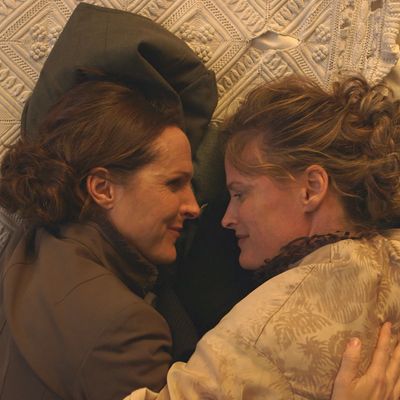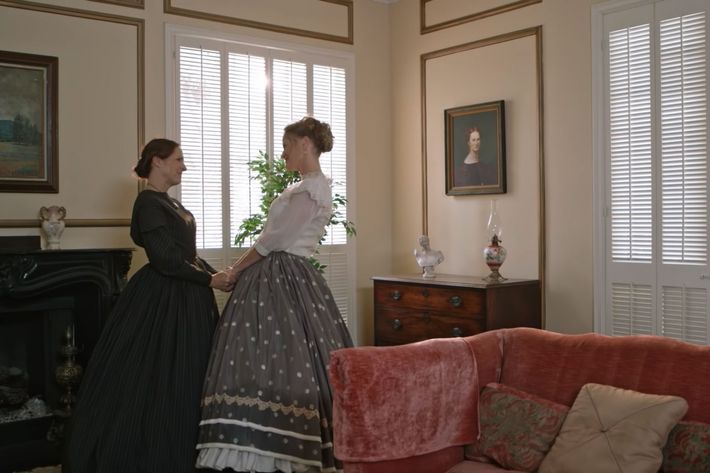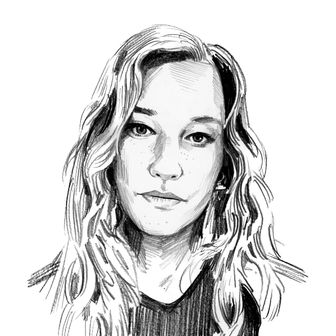
About midway through Wild Nights With Emily, Molly Shannon, playing the iconic American poet Emily Dickinson, sneaks away from a party to meet with her brother’s wife, Susan Dickinson. Giggling mischievously, the two lock themselves in a bedroom above the festivities, fall onto a pile of coats, and begin passionately making out. After a few minutes of kissing, interspersed with joyful gossip about the guests below, Susan pauses. “We should go downstairs,” she says with a trace of sadness. “I want to stay here, on the coats,” says Emily. “Forever.”
It’s one of many such scenes in the funny, sexy, bold new film from writer-director Madeleine Olnek. The story kicks off just as Emily and Susan’s romance does: The two fall in love as schoolgirls performing a play; they pretend to be having chaste sleepovers while they’re peeling off one another’s petticoats; when Susan marries Emily’s brother, she says she’s doing it so that they can live next door to one another for their entire lives; as an adult, a disheveled, grinning Emily races across the lawn at dawn after a hot night at Susan’s.
As a queer woman and an English major who read Emily Dickinson in several classes, I’d only heard light rumblings about her sexuality — and never anything about her being remotely fun. I’d been taught that she was antisocial, afraid of being published, and that she obsessed over mysterious men but never married or found love. Even as recently as three years ago, Terence Davies’s movie A Quiet Passion portrayed Dickinson this way: a lonely woman wracked with vulnerability, in love with a married reverend and, as she grew older, profoundly unable to confront the outside world.
So I was confused and completely intrigued by Olnek’s Wild Nights: Who was this carefree, queer Emily? It turns out, as Olnek tells me, she’d been “hiding in plain sight” this whole time. All it took to bring the real Emily to screen was two women who were willing to do their homework, one being the director herself and the other being the distinguished scholar-teacher, professor of English, and founding director of the Maryland Institute for Technology in the Humanities, Martha Nell Smith.
Smith has devoted most of her career to studying Emily Dickinson. She and Ellen Louise Hart published a book in 1998 called Open Me Carefully: Emily Dickinson’s Letters to Susan Huntington Dickinson. The book is a compilation of Emily’s letters to Susan, which began a few years before Susan married Austin Dickinson and continued until the end of Emily’s life. The letters are erotic and beautiful and undeniably expressions of romantic love; Emily writes about wanting to hold, kiss, and caress Susan and, as Smith puts it, “expresses self-consciousness about that desire.”
Smith found the subject of her book almost by accident. Originally, she was on a mission to figure out if Emily ever tried to publish her poetry when she was alive. But in the process of attempting to read copies of every letter Emily had written, Smith got distracted. “I start coming across things like seven lines erased, half of the page cut out, words erased,” she tells me. “And I’m like, What in the world is this? And so I asked to go see the manuscripts at Amherst College — that’s where most of the mutilated manuscripts are.” Once there, new spectrographic technology made it possible for Smith to recapture what had been censored on the pages and to quickly realize that the lines being erased were “these affectionate expressions about her sister-in-law, Susan.”
“When I started reading the correspondence to Susan, I was like, This stuff is pretty sexy,” Smith recalls. “I found myself thinking: If all of this was sent to any man in Dickinson’s life, there wouldn’t be any kind of argument about who was the love of her life.”
Wild Nights With Emily spends significant time with the person Smith now knows is responsible for mutilating Emily’s letters: Mabel Loomis Todd, a woman who was having an affair with Susan’s husband (and Emily’s brother), Austin. Despite never having met Emily face-to-face, Todd acquired the letters after Emily’s death via Austin and Emily’s sister, Lavinia, and set about removing Susan from them before publishing them. “When I showed this movie to the Emily Dickinson International Society last summer,” Olnek recalls, “the president of the board said, ‘What people need to understand is that when Emily Dickinson scholarship started, people didn’t know that Mabel was Austin’s mistress. They just thought she was the nice, young wife of a faculty member at Amherst College. They didn’t understand her stakes in spinning a certain kind of story about Emily.’”
According to Olnek, Mabel’s redacted versions of Emily’s letters set into motion a kind of bias — “Once there was this image of Emily Dickinson, she was a very safe woman to champion, the myth version of her.” This mythical Emily is at the center of Davies’s film, with which Smith is quite familiar: Before A Quiet Passion premiered, Harvard invited Smith to screen it and offer feedback. Just as Olnek eventually did, Smith found the film to be “miserable.” “I was like, Holy shit — I can’t stand this,” Smith says, laughing. “So when he asked me afterwards what I thought of the movie, I said, ‘Everybody who has a passion for Emily Dickinson is just very invested in their particular [vision] of her. And your vision and mine are very, very different from one another.’ I thought, I just don’t want to have a huge fight with him right here.”
Comportment aside, Smith was angry. “Because I knew that he’s a gay director,” she says. “And [Davies’s movie] seemed to me kind of homophobic. But you and I both know that a lot of gay people have internalized homophobia. So I point-blank asked him. We were staying in the same hotel, and we got on the elevator at the same time. He said, ‘You really didn’t like my movie, did you?’ And I said, ‘I didn’t say I didn’t like it, Terence.’ And I just repeated that we had different visions. But I said, ‘By the way, I’m just curious about you reading her letters. How do you square the fact that she wrote Susan Dickinson far more than she wrote anybody else?’ And he looks at me and says, ‘Oh, I didn’t have time to read the letters.’”
One of the major differences between A Quiet Passion and Wild Nights, Smith says, is that Olnek did her homework. “She asked me so many questions as she was working on the film, and wouldn’t just accept my answers, but would double-check them to make sure I was right,” says Smith. “If you’re gonna make a movie like this, I think you should do your homework.” Nonetheless, Olnek has already faced naysayers. “There wasn’t a single review of A Quiet Passion that said, ‘This is not accurate,’ whereas I’ve gotten that a lot: ‘Oh, what’s this based on?’ And really angry responses, like, ‘She’s making this up,’” Olnek says. “Considering how much time I’ve spent researching this, and considering how many resources that movie had — there’s one movie about Emily Dickinson, and they can’t get it right? I feel like [the real] story has just been hiding in plain sight.”

Smith isn’t the first scholar to posit that Emily was a lesbian, or that she’d had a romantic relationship with Susan. In 1951, Rebecca Patterson published The Riddle of Emily Dickinson, which suggested the subject of Emily’s poems was a woman; as a 2010 New York Times piece put it, she “took a lot of heat for it” and “scholars demolished its thesis.” “The Lavender Scare was at full tilt,” explains Smith of the book’s public rejection. “It’s just good old homophobia.” She adds that she has old correspondence of Patterson’s, in which Patterson wrote to publishers about a second book focusing on the homoerotic, “clitoral” imagery in Emily’s poems, but the publishers rejected both the book and the notion.
In the 1970s, Lillian Faderman tried yet again to demonstrate the truth of Emily’s queerness and love for Susan, but, as Smith explains, “I think she got caught up in trying to concede the relationship between Emily and Susan in the context of ‘women’s relationships.’ And it’s true that many women’s relationships did lead to expressions of great affection in letters exchanged between women in the 19th century. But what separates Dickinson’s from other people’s is that Dickinson is very self-conscious about what she says to Susan.”
Susan’s own daughter, Mattie, was one of the first to publicly state the nature of her mother’s relationship with Emily. She dedicated the first collection she published of Emily’s, The Single Hound, as follows: “This is my inspiration for a volume, offered as a memorial to the love of these ‘Dear, dead women.’” But, as Smith explains, by the time this volume was published in 1914, homosexuality had been pathologized. Smith believes Mattie’s friend Alfred Hampson (“Who was gay, by the way,” adds Smith) persuaded Mattie to take some of the focus off Susan and Emily’s relationship, because then she’d be able to find a wider audience for the book.
Those who make a case for Emily’s heterosexuality often point to her “Master Letters” — a series of letters addressed only to a mysterious “master” — as well as her correspondence with a family friend named Judge Otis Phillips Lord. Many scholars believe these constitute proof that Emily was interested exclusively in men. Or at the very least, in men as well as women. “There is evidence for her loving both women and men,” another Dickinson scholar, Professor Peggy McIntosh, tells me. “My feeling is that human beings who are in touch with their feelings will feel affinities with whoever they are attracted to, regardless of the person’s gender. I hope you will be not be convinced by those who portray Emily Dickinson only as a lesbian.”
After studying these letters intensively, Smith believes the “Lord letters” are less full-fledged correspondence and more illegible scraps. As for the “Master Letters,” well, Smith says those are Emily’s attempt at epistolary fiction. (She’s not the first scholar to argue this.) Olnek adds that there’s significant evidence — including in The Riddle of Emily Dickinson — that “Master” was actually Kate Scott Turner, a woman pictured in the only existing daguerreotype of Emily, who is believed to have had a brief, passionate affair with Emily. The date of her drafts to “Master” coincide directly with the dates that Turner visited Emily at her home in Amherst. Most tantalizingly, Emily once mailed Turner (who ended up living an openly gay life in Europe) a poem alongside a pair of garters.
Meanwhile, her letters to Susan, which the two sent back and forth daily despite living next door to one another, are undeniable in their nature. One points to the beginning of their relationship: “I love you as dearly, Susie, as when love first began, on the step at the front door, and under the Evergreens.” Smith points out this letter, in which Emily waxes rhapsodic about nights spent together, as particularly telling; in another, Emily writes, “Now, farewell, Susie … I add a kiss, shyly, lest there is somebody there! Don’t let them see, will you Susie?” When Emily died, Susan was asked to wash her body, an intimate act reserved for those closest to the dead, depicted heartbreakingly in Wild Nights.
Meanwhile, in A Quiet Passion, Susan is not only a straight woman but a “church mouse,” her famously erudite and well-attended literary salons completely ignored. When I reached out to Davies to ask him to hop on the phone for a conversation about his film and about Emily’s sexuality, his assistant replied as follows:
“As far as Terence is concerned the only person who knew, definitively, about Emily Dickinson’s sexuality was Emily Dickinson; and she may very well have been as confused and conflicted about that as we all can be at times throughout our life. One thing that is certain about the human condition is that nothing is ever new, and whatever she may or may not have felt about her sexuality is just as relevant now as it was, for her, then: as is her poetry. One can see whatever one wants to see when picking through the details of someone else’s existence; but the fact remains that we just don’t know, and Terence believes that it is wrong to try and reach a ‘definitive’ conclusion, because that ‘definitive’ conclusion will always be only speculative; no matter how much circumstantial evidence one puts forward. She was what she was. An incredibly interesting human being and an astonishingly brilliant poet; the only relevance her sexuality had (or has) is how it influenced her poetry, and that we will never know. She remains, and always will be, a beautiful, unknowable, enigma …”
Smith took serious umbrage at this. When I asked for her to respond to Davies’s comment, she wrote back in an email, “If he had read her letters, he would know that Emily changed poems at Susan’s behest. Sad to say that Terence didn’t do his homework (that was painfully obvious in so much that was WRONG with his film). He has a very fixed idea about her and didn’t want to learn more (evidently). But that he didn’t read her letters astonishes me.”
“As much as the world has changed, I think there are still even very liberal people who say, ‘Well, yeah, she had this relationship with Susan. But do we have to use the word lesbian?’ There’s still some who are threatened by that,” says Smith. “And they’re also threatened by their intellectual companionship.” She pauses for a moment. “I’ll just say it: I think a lot of men in particular don’t like that.”

Smith concedes that as Dickinson aged, she grew “pickier about who she’d spend time with,” but on the whole, she was a social, loving, and deeply funny woman whose relationships were profoundly important to her. She hates that Davies’s portrayal of Emily was “crabby and mean,” and points me to a specific example of Emily’s singular wit: a joke about flatulence in a letter to Susan that reads, “Dear Susie, I send you a little air.”
Mabel Loomis Todd — who never met Emily (Emily refused to meet her on account of the fact that Mabel was having an affair with her brother), yet became a vocal advocate for her work — had reason to perpetuate a vision of a sheepish, antisocial Emily. Enlisted by Emily’s sister, Lavinia, to help bring Emily’s poems to light, Mabel became an unlikely (and later contested) editor tasked with explaining away her lack of a relationship with the author. “One way to explain [the fact that they never met] is to say she was reclusive,” says Smith. “And the characteristic of being reclusive was one that was easily attached to a woman poet at the time. The composite biography for a woman poet in late-19th-century America was that she was probably writing her poetry because she was suffering some secret sorrow.”
Today, early editions of Emily’s work are in the public domain, including versions edited by both Mabel and Susan’s daughter. Olnek and Smith are hopeful that their deeper dive into the truth of Emily’s life will supersede the image of a lonely, morose spinster who hovers over her American canon. “We lose her humanity, not understanding how she worked, how she lived her life. Emily Dickinson did not die miserable and alone as Terence Davies would have you think,” says Olnek. “That almost seems like the price she paid in order to write this way. Who would want that? What young person would want that? She lived on her own terms, which is different than living ‘crazy.’”
“Davies’s fixed idea about Emily is that she was writing out of lack,” says Smith. “The record shows that she was writing out of abundance.”



